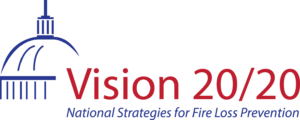
The Vision 20/20 Project – National Strategies for Fire Loss Prevention is guided by a coalition of national organizations who collectively exemplify how collaboration, communication, and the commitment to data-based solutions can save lives and property. The International Association of Wildland Fire brings a global and local focus to prevention with their seat on the Vision 20/20 Steering Committee table.
Steering Committee members from across the nation assembled in Baltimore Maryland April 16 and 17, 2019 for their most recent meeting, and IAWF was represented by IAWF board member Kathy Clay. Under the guidance and leadership of Project Manager Jim Crawford, retired Deputy Chief/Fire Marshal Vancouver, WA, stakeholder partners were given update reports on the mission and work of the Vision 20/20 effort in reducing community risk.
Five strategies guide the group working to fill the gaps in fire prevention:
- Advocacy
- Outreach and Education
- Culture
- Technology
- Codes and Standards
Sharing what others are doing across the nation sprouted the first Models in Fire Prevention Symposium in 2010, which has continued every other year since. The reports provided from prevention-focused presenters from across the nation in many lines of work can be found on the Vision 20/20 website https://strategicfire.org at the Home/History of Vision 20/20 tab.
This website is an abundant resource for prevention advocates, offering a plethora of tools for the prevention advocate including:
- The Fire Safety Materials Generator for creating customized community flyers can be found under the Education tab
- Podcasts, training, and networking under the Community Risk Reduction (CRR) tab
- Symposium materials, case studies, toolkits, logos, videos, success stories and more

After the Steering Committee meetings were concluded at noon on the 17th, Jim Crawford was presented the Community Hero Award for his tireless work on community risk reduction by Johns Hopkins University – a very hard-earned, deserved award, indeed.
Next up and held in Feinstone Hall at Johns Hopkins Bloomberg School of Public Health, was the annual Daniel J. Raskin Memorial Symposium. “2018 California Wildfires: Lessons learned for public health from coast to coast” was presented in honor of fallen firefighter Daniel J. Raskin. The panel discussion was facilitated by former California Fire Marshal and current National Fire Academy Superintendent, Tonya Hoover. Joining her were retired CAL Fire Chief Ken Pimlott, Michael Gollner, Associate Professor Department of Fire Protection Engineering at the University of Maryland, College Park; and Michele Steinberg, Wildland Fire Manager, National Fire Protection Association.
Chief Pimlott provided comments on the difficulty of fighting wildland fire with extreme wind conditions, the inability to put aircraft in the air under these conditions, and the inability to build accurate situational awareness during high-wind, fast-moving events. Michael Gollner (IAWF Board member) discussed the 2018 fires, evacuation challenges, the role of (community?) design, and research being conducted on long-term exposure to wildland smoke. Michelle Steinberg (IAWF Board member) spoke on the human dimensions of wildland fire, including planning at local levels, managing the existing homes and construction, and changing behaviors into positive action. A question and answer period followed when audience members inquired about current smoke research and the risk of wildland fire to property east of the Mississippi.
As wildland fire becomes a risk to more and more communities, the voice of the International Association for Wildland Fire will help guide policy-setters and decision-makers in the quest to save lives and lower property losses to wildland fires across the nation.
Partners in the Conversation
Partners in this important national conversation include:
- American Red Cross
- Center for Public Safety Excellence
- Institute of Fire Engineers
- Insurance Service Office
- International Association of Black Professional Fire Fighters
- International Association of Fire Chiefs
- International Association of Fire Fighters
- International Association of Women in Fire and Emergency Services (iWomen)
- International Code Council
- International Fire Marshals Association
- International Fire Service Training Association
- Johns Hopkins University Center for Injury Control and Policy Prevention
- National Association of Hispanic Fire Fighters
- National Association of State Fire Marshals
- National Fallen Fire Fighters Foundation
- National Fire Protection Association Education Section
- National Institute of Standards and Technology
- National Volunteer Fire Council, Society of Fire Protection Engineers
- Underwriters Laboratories
